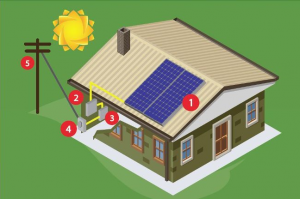Frequently Asked Questions

A Residential Solar Energy System is a simple way to protect the environment, and realize immediate financial benefits. Very simply, your system consists of five basic components:
1 –Solar Modules:- Mounted on the roof top of your residence in clear view of the sun
- The sunlight is directly converted into DC power through solar cells
- Converts DC power produced from the solar modules, into usable AC power
- AC power is the same type of electricity provided by your local utility
- Before the AC power reaches your home, it is received by the electrical service panel
- Electricity is then distributed as needed to your home
- The utility meter measures the amount of electricity provided to your home by your local utility
- The electricity produced by your solar energy system offsets the measurement (essentially the meter spins in reverse)
- The utility grid is controlled by your electric company and it provides electricity automatically when needed “on demand”
- During the day, excess solar production provides energy offset credit; during the night power is readily available from the grid for your home.
Each and every project is custom designed depending on the installation and the facility. A typical roof mount to a custom installation can range from $3.50 – $8.00 per watt with everything included.
Unfortunately, this is a piece that is out of everyone’s control. Whether you are waiting for a State Rebate or a Utility grant, when you turn in your application there is a process that your application will need to go through for all the necessary steps for approval. There are estimates of timelines for this that we can share with you, but nothing is guaranteed.
Day & Night Solar has funding sources available for both commercial and residential applications. Depending on the size of the project and credit scores, this can be taken advantage of at 100% of the project cost and make the system cash flow neutral and/or positive over the payment period.
Although pricing is continuing to go down, so are the rebates and incentives. As goals are met at the state and utility level, we expect to continue to see a decline. With that being said, you have more of an advantage to take the incentives today and begin saving on your utilities.
Photovoltaic technology has been around for over 100 years. The core technology is not changing. What has changed is the efficiency of the conversion of power from DC to AC at the inverter. With the inverters running at a 96-98% efficiency, it is not expected to increase drastically.
In most cases you cannot install ahead of time and then submit an application and expect to be approved for funding. There are procedures put in place for a couple of reasons. First, to insure the end user is getting a system that performs and will offset their power along with following the proper installation code. Second, for security to linemen that will be working on the utility grid when a power outage occurs.
A “Renewable Energy Credit” or “REC” is a trade-able credit that represents the environmental attributes of a certain amount of energy produced from a renewable energy resource. Depending on where you live and what incentives are available, this is either kept by the power company when you receive your rebates or you keep them and have the ability to sell them as a commodity.
For any applicant to have an optimal solar exposure, they will have to have southern facing, non-shaded, physical space. Solar does not work well in a shaded area and can drastically reduce the power output. Along with this issue, you will not receive a grant/rebate for an array unless you hit an recommended output percentage.
Our panels come with a standard 25 year warranty and a life expectancy of 50 to 60 years. As utility costs continue to raise the value of solar, the value of your home or business will increase.
We recommend cleaning once a year, typically after pollen season using only mild soap and water from a garden hose. Do not use a power washer on your panels as you risk breaking the seals. If you are in a high industrial area or in new construction, you may need to clean them more often.
Panels are rated with the 1” ball beaing test just like the windshield of your car. If hail can break your windshield, it can break a panel. This would be covered under your insurance policy.
Traditionally Solar is thought of as having battery storage. Although you may add batteries, most incentives available today do not allow for batteries. All systems are grid tied, thus offsetting the power you consume. If there is excess production, it is fed to the grid as your meter spins backwards.